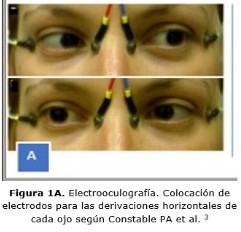The placement of the electrodes for the electronystagmography record
Keywords:
Sistema Vestibular, electronistagmografía, electrodos, movimientos oculares, nistagmo.Abstract
Background: quality of record of electronystagmography during the studies of the vestibular system depends on the proper selection and placement of the electrodes, which are usually located at specific points in the eye socket to allow the collection of the variation of electric potential generated between the cornea and the retina caused by the jerking of the induced or natural nystagmus.
Objective: to present the experimental results that demonstrate this influence by quantifying the effect on the records.
Development: it was used the technique of visual stimulation with moving target at different frequencies of movement, and the records were made under the lighting conditions established in the published standard for electrooculography, using a two-channel amplifier with a sampling frequency of 1 kHz. The results obtained reflect the change in the tensions in the records according to the electrode placement zone, there being an optimal zone for the adequate record of electronystagmography.
Conclusions: the affectation by zones in the records in the temporal domain and the frequency was demonstrated, and its influence in the generation of errors in the topographic diagnosis of diseases that affect the Vestibular System.
DeCS:ELECTRONYSTAGMOGRAPHY/methods; ELECTRODES, IMPLANTED; VESTIBULAR DISEASES; EYE MOVEMENTS; PHOTIC STIMULATION.
Downloads
References
1. Gila L, Villanueva A, Cabeza R. Fisiopatología y técnicas de registro de los movimientos oculares. Anales del Sistema Sanitario de Navarra. 2009;32:9-26.
2. Leigh RJ, Zee DS. The neurology of eye movements: Oxford University Press, USA; 2015.
3. Constable PA, Bach M, Frishman LJ, Jeffrey BG, Robson AG. ISCEV Standard for clinical electro-oculography (2017 update). Documenta Ophthalmologica. 2017;134(1):1-9.
4. Baloh RW, Kerber K. Baloh and Honrubia's clinical neurophysiology of the vestibular system: Oxford university press; 2011.
5. Claussen PDC-F, Bergmann DmJM, Bertora DmGO. Equilibriometría y Tinnitología Práctica. NEUROOTOLOGISCHES FORSCHUNGSINTITUT DER 4-G-F FORSCHUNG EV D-97688 Bad Kissingen Germany. 2009:219.
6. Jonathan Esteban Sánchez EMS. Exploración Otoneurologica. Primera edición impresa en lengua española 2016 ed. España: Amplifon Ibérica,; 2016 2016. 120 p.
7. Slama AB, Mouelhi A, Cherni MA, Manoubi S, Mbarek C, Trabelsi H, et al., editors. Features extraction for medical characterization of nystagmus. 2016 2nd International Conference on Advanced Technologies for Signal and Image Processing (ATSIP); 2016 21-23 March 2016.
8. Barea R. Interfaz Usuario-Máquina basado en electrooculografía. Aplicación a la ayuda a la movilidad: Tesis doctoral. Madrid: Universidad de Alcalá de Henares; 2001.
9. Carlos R. Vázquez Seisdedos ABGM. SACADEX 3: NUEVA HERRAMIENTA PARA EL ANÁLISIS DE MOVIMIENTOS OCULARES DE PERSECUCIÓN SINUSOIDAL. XV Convención y Feria Internacional Informática 2013 Congreso Integracionista de las Ciencias y las Tecnologías Informáticas; 2013; La Habana. La Habana2013.
10. Alberto Barrientos Castaño, Maritza Herrera Mora, Obel García Báez, Milagros Sierra Hernández, Rosa OPdl. Valores de referencia del electrooculograma. Revista Cubana de Plantas Medicinales. 2012;31(1):46-52.
11. Socarras BN, Herranz AC, Domínguez DC, Morlán CBB, Gómez AR. Caracterización de la adquisición de nistagmos asociados al estudio del sistema vestibular. Revista Cubana de Ingeniería. 2017;7(3):5-14.
12. Pérez N. Atlas de pruebas vestibulares para especialistas en otorrinolaringologia. Barcelona: Profármaco. 2009;2:207.

Published
How to Cite
Issue
Section
License
Copyright: Camagüey Medical Archive Magazine, offers immediately after being indexed in the SciELO Project; Open access to the full text of the articles under the principle of making available and free the research to promote the exchange of global knowledge and contribute to a greater extension, publication, evaluation and extensive use of the articles that can be used without purpose As long as reference is made to the primary source.
Conflicts of interest: authors must declare in a mandatory manner the presence or not of conflicts of interest in relation to the investigation presented.
(Download Statement of potential conflicts of interest)
The Revista Archivo Médico de Camagüey is under a License Creative Commons Attribution-Noncommercial-No Derivative Works 4.0 International (CC BY 4.0).
This license allows others to distribute, to mix, to adjust and to build from its work, even for commercial purposes, as long as it is recognized the authorship of the original creation. This is the most helpful license offered. Recommended for maximum dissemination and use of licensed materials. The full license can be found at: https://creativecommons.org/licenses/












 22 julio 2025
22 julio 2025